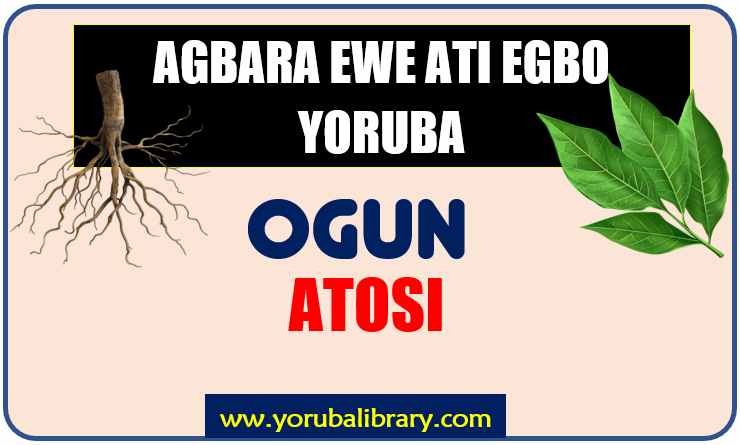
support@yorubalibrary.com
+2348073529208, 07038599574

Among the Yoruba, health was never seen as only a physical matter but also a spiritual balance and discipline. Diseases of the body, especially those connected with sexual organs, were treated with seriousness because they affected not just the individual but also family honor and fertility. One such condition was Atosi (gonorrhea), a painful and shameful illness that caused discomfort, weakness, and sometimes long-term damage if left untreated.
Our forefathers in Yoruba land, in their wisdom, developed Ogun Atosi, a traditional healing system designed to cleanse the body of infection, reduce pain, restore reproductive health, and renew spiritual purity. Yoruba understanding of disease went beyond bacteria or germs; Atosi was believed to be caused not only by sexual misbehavior but also by spiritual imbalance, curses, or neglect of personal discipline.
For years bacck, this practice helped men and women recover from venereal infections at a time when hospitals and modern antibiotics were unavailable. Even today, some families still remember and pass down these remedies as part of cultural heritage, both for their cleansing effect and for their ancestral wisdom.
Disclaimer
Yoruba Library and its Team will not be held liable for improper usage or any loss arising from improper use, wrong application, inability to find needed materials, or misinterpretation of this article. This article is provided strictly for guidance and educational purposes.
Symptoms of Atosi (Gonorrhea)
In Yoruba tradition, elders and healers paid close attention to the physical, behavioral, and spiritual signs of Atosi. These guided them in knowing when and how to prepare remedies:
• Frequent urination with burning pain – A sharp, hot sensation when passing urine.
• Discharge – Thick, whitish, or yellowish discharge from the private part.
• Genital pain – Itching or soreness around the organ.
• Weakness in the waist – Men especially complained of aching loins and reduced strength.
• Pain during intimacy – Discomfort that discouraged sexual activity.
• Shame and withdrawal – The person often avoided social gatherings out of embarrassment.
• Restlessness at night – Discomfort leading to lack of sleep.
Yoruba Elders understood that these signs were not to be ignored. Remedies were prepared not only to treat the body but also to restore the person’s confidence.
How Our Forefathers Treated Atosi in the Past
When gonorrhea was suspected, Yoruba healers followed a structured process, combining herbal, physical, and spiritual methods:
• Washing and steaming —
Genitals were sometimes steamed or washed with herbal water to ease pain and reduce discharge.
• Poultices and pastes —
Some remedies were pounded and applied externally around the lower abdomen or genital area.
• Dietary and sexual discipline —
Patients were often forbidden from eating certain foods or engaging in intimacy until fully healed.
• Herbal decoctions —
Roots and leaves were boiled to prepare drinks for internal cleansing. Potent leaf previously used in treating Atosi include:
1) Ewe Abafe
2) Ewe Lapa Pupa
3) Ewe Ewe Jogbo
4) Ewe Apá
5) Eso Orombo
6) Ewe Botuje
7) Egbo Ako Ibepe
Through these methods, Yoruba medicine aimed not only at relief from symptoms but also at the full restoration of health, confidence, and spiritual strength.
Have you heard of Yoruba Herb Dictionary? This contains names of Yoruba Leaf, Roots, Barks, Characteristics, Properties & Identification with HD Pictures. Order below or download sample here
A-Z HERBS & LEAF DICTIONARY #4KOne Yoruba proverb says "Bí olóde ò kú, òde rè kì í wu Gbégi". Do you know that Gbégi is actually a leaf/plant? Get Yoruba Proverbs on Plants and Herbs, which is a collection of Untold Wisdoms Hidden in Leaf and plants comprising their Life Applications & Moral Teachings. Order below or download sample here
YORUBA PROVERBS ON PLANTS #4KThe Healing Process in Traditional Practice
When elders prepared Ogun Atosi, the steps followed were both physical and spiritual to ensure lasting effectiveness:
• Selecting herbs and roots believed to strengthen the bladder and calm the nervous system.
• Preparing powders, concoctions, or washes depending on the healer’s guidance.
• Administering medicine at specific times (often before bedtime).
• Observing progress while maintaining dietary restrictions for better effect.
Differences Between Yoruba and Modern Bedwetting Treatment
While both Yoruba healing and modern medicine aim to cure Atosi (gonorrhea), the approach differs:
• Focus —
Yoruba healing emphasizes genital subconscious; modern medicine focuses on physical weakness.
• Materials —
Traditional methods use herbs, roots, and spiritual reinforcement; modern treatment uses machine and chemicals
Safety First: Important Contraindications and Considerations
• Underlying conditions —
Some medicinal preparation not ideal for lactating mothers.
Needed Materials (Leaves, Roots, Bark, etc.)
The medicinal approach for this requires careful selection of natural materials traditionally known to our elders. These are combined to ensure potency.
The instruction you will receive is the original account of our forefathers, preserved and tested over time. Many people have used them with testimonies of relief. Just ensure you follow the correct guidelines. Click Unlock Secret below
Application Process
The strength of Yoruba medicine depends on how materials are handled. Proper pounding, boiling, or steeping — done in the right way and at the right time — ensures the remedy remains potent. Click Unlock Secret below
Uses
The prepared remedy must be applied in the correct manner — whether for drinking, steaming, bathing, or chest rubbing — and taken in the right dosage for it to remain effective.
1) Some leaf required special utterances/chants before they can be effective. Where applicable, this will be stated in the PDF
2) The methods of getting the needed items like leaf, bark, roots by yourself is covered in the PDF
3) Saa bi Ologun ti wi, ki o le baa je... (Follow instructions for it to remain potent). You're getting a Real and Original account of our fore fathers.
With Numerous Satisfied Clients...